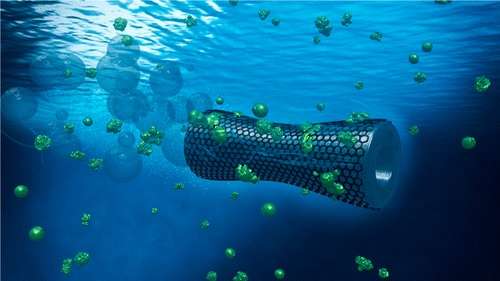April 11, 2016 feature
Microbots can clean up polluted water

(Phys.org)—A new study shows that a swarm of hundreds of thousands of tiny microbots, each smaller than the width of a human hair, can be deployed into industrial wastewater to absorb and remove toxic heavy metals. The researchers found that the microbots can remove 95% of the lead in polluted water in one hour, and can be reused multiple times, potentially offering a more effective and economical way to remove heavy metals than previous methods.
The researchers, Diana Vilela, et al., have published a paper on the lead-adsorbing microbots in a recent issue of Nano Letters.
"This work is a step toward the development of smart remediation system where we can target and remove traces of pollutant without producing an additional contamination," coauthor Samuel Sánchez, at the Max-Planck Institute for Intelligent Systems in Stuttgart, Germany; the Institute for Bioengineering of Catalonia in Barcelona; and the Catalan Institution for Research and Advanced Studies in Barcelona, told Phys.org.
Heavy metal pollution in water is a common problem stemming from industrial activities, including the manufacturing of batteries and electronics, as well as mining and electroplating. These activities produce metals such as lead, arsenic, mercury, cadmium, and chromium, all of which pose a safety hazard to living organisms and the environment.
In the new study, the researchers focused specifically on removing lead from wastewater by designing tube-shaped microbots with three functional layers. The outer layer of graphene oxide adsorbs the lead from the water. The middle layer, nickel, makes the microbots ferromagnetic so that their direction of motion can be controlled by an external magnetic field. The inner layer, platinum, gives the microbots the ability to self-propel themselves through water. When hydrogen peroxide is added to the wastewater, the platinum decomposes the hydrogen peroxide into water and oxygen microbubbles, and ejecting the microbubbles from the back of the microbot propels it forward.
When the microbots are finished adsorbing the lead, a magnetic field can be used to collect them all from the water. Then the microbots are treated in an acidic solution to remove the lead ions, which can later be recovered and reused. The microbots can also be reused for further lead clean-up.
"This is a new application of smart nanodevices for environmental applications," Sánchez said. "The use of self-powered nanomachines that can capture heavy metals from contaminated solutions, transport them to desired places and even release them for 'closing the loop'—that is a proof-of-concept towards industrial applications."
In the future, the microbots could even be controlled by an automated system that magnetically guides the swarm to accomplish various tasks.
"We plan to extend the microbots to other contaminants, and also importantly reduce the fabrication costs and mass-produce them," Sánchez said.
The combination of self-propelled robots with functional layers also opens the doors for similar designs that could have applications in areas including drug delivery and sensing.
More information: Diana Vilela, et al. "Graphene-Based Microbots for Toxic Heavy Metal Removal and Recovery from Water." Nano Letters. DOI: 10.1021/acs.nanolett.6b00768
Journal information: Nano Letters
© 2016 Phys.org



















